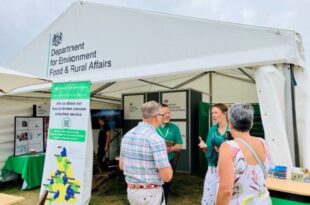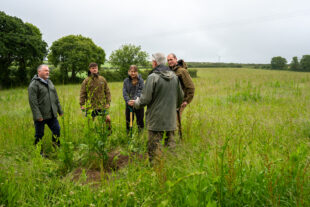https://defrafarming.blog.gov.uk/convert-arable-land-to-permanent-grassland/
Convert arable land to permanent grassland
The guidance on this page is for SFI pilot participants only. Please visit GOV.UK for the official Sustainable Farming Incentive scheme guidance.
Find out how land managers can convert arable land to permanent grassland to benefit soil health, water quality, landscape and wildlife.
About permanent grassland
Permanent grassland is land used for 5 consecutive years or more to grow grasses, legumes, herbs or wildflowers. What you grow will depend on what you want to achieve.
You’ll usually maintain permanent grassland with very low inputs. Where conditions allow you can create species-rich grassland.
You can create permanent grassland in any part of the country. It works best on sites where arable farming or intensive grassland production causes soil erosion and runoff.
Benefits of permanent grassland
Wildflowers will increase the supply of nectar and seeds for wildlife.
Converting arable land to permanent grassland is a long-term commitment. For the farm it will:
- protect soil from surface runoff and erosion
- help improve water quality
- protect historic features from damage
For the wider environment, permanent grassland will help to:
- provide new habitats for wildlife, especially where arable farming dominates
- encourage wildlife to move more easily across the landscape
- reconnect habitats that have been fragmented
- provide a buffer between sensitive habitats and farming activities
How to convert to permanent grassland
Before you start
Assess the potential for creating permanent grassland. Identify your soil type, soil pH and nutrient status, and complete a soil runoff and erosion risk assessment. This will help you decide which type of grassland to create.
Check if the land you want to convert has any existing wildlife or plants that would be affected. Do not convert land if there are protected species present like rare arable plants, or farmland birds like corn bunting, stone curlew or lapwing.
Register and request an SFI Historic Environment Farm Environment Record (SFI HEFER) to learn more about historic features on your land. You’ll need to get consent from Historic England if work affects a scheduled monument.
If you have livestock, you’ll need fencing and access to a water supply. Read about how to apply for grants for capital items, including fencing.
If you have no livestock you’ll have to cut and remove the crop. Find out how to manage your grassland.
Prepare the site
On temporary grassland, remove any existing sward using a herbicide before preparing a seedbed.
Find out how to remove soil compaction to prepare the seed bed for sowing. Do not disturb the soil if you’re converting land to grassland to protect historic features.
What to sow
Choose a seed mix to match the soil conditions on your site. Your agronomist can help with this.
To improve water quality, choose species that will establish quickly and can thrive under low-input management.
Use harvested seed like green hay, or seed mixes from commercial suppliers.
Select at least 6 different types of grass that grow well in low-input grassland. These can include tussock-forming species such as cock’s-foot. This will give the grassland a more natural appearance and provide habitats for invertebrates.
On sites with high nutrient levels you can grow wildflowers, like:
- black knapweed
- ox-eye daisy
- self-heal
Many sites can suffer from low levels of nitrogen in the first few years. On these sites, grow legumes, like:
- red clover
- bird’s-foot trefoil
- tufted and common vetch
On historic features, do not grow plants whose roots could damage the features. These include deep rooted legumes like sainfoin and lucerne.
On sites with low nutrient levels you may be able to create species-rich grassland.
You can harvest seed locally or ask conservation organisations if they have any harvested seed from a suitable donor site. This can be cheap compared with buying seed mixtures, but availability can be limited.
Use a donor site big enough to supply the target site. As a guide, seeds taken from 1 hectare (ha) should be enough to spread on to 3ha.
You must have an Animal Plant Health Agency (APHA) licence to harvest and transfer seed in England.
Sow your seed mix
Spread the seed from late July to early September as this is when most grassland plants set seed. You can also establish grassland in the spring if soil and weather conditions are suitable.
You can use a modified seed hopper to scatter seeds on larger fields. Use extra agitators in the hopper if you’re spreading brush harvested seed, in case there’s material like stalks or leaves.
On land with historic features you can also direct drill or spread seed by hand.
Seed needs to be in contact with the soil to germinate. You can do this by rolling the site straight after spreading the seed.
Management in the first year
Cut or graze regularly in the first year to promote grass growth and control weeds. The right time to start this process depends on the growth rate of your vegetation and the need to control weeds.
On species-rich grassland, remove the cuttings to avoid adding nutrients to the soil.
Find out how to maintain permanent grassland with very low inputs.
Weed control
Vigorous weed species can be a problem until you’ve established a dense grass sward. These include:
- creeping thistle
- broad-leaved dock
- nettles
- rushes
- common ragwort
You can manage invasive and competitive weeds by:
- cutting
- grazing
- weed wiping
- spot treatment
What successful converted permanent grassland looks like
You’ll see:
- a dense sward with little or no bare ground
- little or no runoff and erosion
- more wildflowers, insects and birds than before you converted the land



